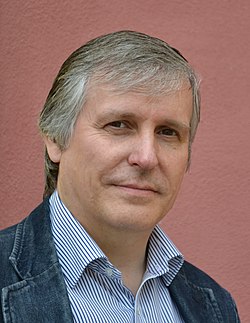Portal:Video games
The Video Games Portal

A video game or computer game is an electronic game that involves interaction with a user interface or input device (such as a joystick, controller, keyboard, or motion sensing device) to generate visual feedback from a display device, most commonly shown in a video format on a television set, computer monitor, flat-panel display or touchscreen on handheld devices, or a virtual reality headset. Most modern video games are audiovisual, with audio complement delivered through speakers or headphones, and sometimes also with other types of sensory feedback (e.g., haptic technology that provides tactile sensations). Some video games also allow microphone and webcam inputs for in-game chatting and livestreaming.
Video games are typically categorized according to their hardware platform, which traditionally includes arcade video games, console games, and computer games (which includes LAN games, online games, and browser games). More recently, the video game industry has expanded onto mobile gaming through mobile devices (such as smartphones and tablet computers), virtual and augmented reality systems, and remote cloud gaming. Video games are also classified into a wide range of genres based on their style of gameplay and target audience. (Full article...)
Featured articles –
The six main playable characters in Final Fantasy VIII are Squall Leonhart, a loner who avoids vulnerability by focusing on his duty; Rinoa Heartilly, an outspoken and passionate young woman who follows her heart; Quistis Trepe, an instructor with a serious yet patient attitude; Zell Dincht, an energetic martial artist with a fondness for hot dogs; Selphie Tilmitt, a cheerful girl who loves trains and flies the airship Ragnarok; and Irvine Kinneas, a marksman and womanizer who uses his charm to mask his insecurities. Temporarily playable characters include Laguna Loire, Kiros Seagill, and Ward Zabac, who appear in "flashback" sequences; SeeD cadet-turned-antagonist Seifer Almasy; and sorceress Edea Kramer. The main antagonist is Ultimecia, a sorceress from the future who wishes to compress time. (Full article...)
Rare was a prominent second-party developer for Nintendo in the 1990s, and their Killer Instinct series was produced as an exclusive partnership in response to the popularity of Mortal Kombat. Following the success of the 1995 Killer Instinct port for the Super Nintendo Entertainment System, Rare began a sequel for the same platform but transitioned development to its successor, the Nintendo 64, upon its unveiling. Gold was scheduled as a launch title for the new console but was delayed until its North American release in November 1996. It was released in other regions in May 1997. Gold was later included in Rare's 2015 Xbox One retrospective compilation, Rare Replay.
Reviewers preferred the Nintendo 64 port over the arcade release, and appreciated its audiovisual enhancements, but felt that its graphical upgrades and memorization-based combo gameplay were insufficient when compared to fighting games like Tekken 2 and Virtua Fighter 2. Critics recommended Gold primarily for fans of the series and genre, but IGN reported that even fans were upset by changes in the combo system and the absence of several well-liked characters. Gold ultimately did not replicate the success of its Super NES predecessor, and the series remained dormant through its 2002 acquisition by Microsoft until its 2013 reboot. (Full article...)
Lost Coast is a technology demonstration showcasing the high-dynamic-range rendering implemented in the Source engine. It was designed with environments to emphasize these effects. Lost Coast was the first Valve game with a commentary mode, in which the developers explain elements of design as the player progresses through the level.
The Lost Coast level was created for Half-Life 2, but was removed from the game. It was originally going to be a level in "Highway 17" where Gordon ends up in a strange place meeting a Fisherman. As a result, it has several minor story details that were not included in Half-Life 2. It received a generally positive reception, and there was consensus among reviewers that the new features included in Lost Coast should be integrated into future games released by Valve. (Full article...)
Did you know... -
- ... that Justin Yu, the current Classic Tetris World Champion, is also a cellist in MIT's video game orchestra?
- ... that the character Psycho Mantis in the video game Metal Gear Solid breaks the fourth wall by identifying the player's other games?
- ... that, near the ending of the 2005 interactive storytelling video game Façade, two characters portrayed through AI chatbots ask the player for relationship advice?
- ... that the video game Fursan al-Aqsa received an update that allows players to reenact the October 7 attacks on Israel?
- ... that the case Lewis Galoob Toys, Inc. v. Nintendo of America, Inc. was considered essential to the future of video game modding in the United States in 1992?
- ... that the 1992 video game Otogirisō reinvigorated interest in adventure games in Japan?
- ... that Kainé from the video game series Nier was created in response to a female staff member's vague wish for a "male heroine"?
- ... that the video game mode Ultimate Team has been criticized for its reliance on loot box packs, considered to be a controversial form of gambling?
- ... that the 2014 text adventure The Uncle Who Works for Nintendo is inspired by a source cited by children for spreading video game rumors?
- ... that the team developing the action video game Knights Contract researched European folklore on witches and witch hunts?
- ... that Goodboy Galaxy was the first commercially released video game for the Game Boy Advance in more than 13 years?
- ... that the urban legend Herobrine was ranked on a Guinness World Records poll of the best video game villains, despite never existing?
Selected biography –
Selected image -

Recent video game-related events
- April 4, 2025 – Tariffs in the second Trump administration
- Multiple companies, including Klarna, StubHub, Nintendo, and Professional Sports Authenticator, pause price-sensitive business actions in the U.S. to evaluate the impact of the recent tariff announcements. (The Wall Street Journal) (IGN) (The Verge)
- January 16, 2025 –
- Nintendo officially reveals the Nintendo Switch 2 video game console, the successor to the Nintendo Switch. (Nintendo)
- September 12, 2024 – 2023–2024 video game industry layoffs
- Microsoft announces that it will lay off 650 Microsoft Gaming employees as part of cuts to its workforce. (Variety)
Topics
Categories
Things you can do
In other Wikimedia projects
The following Wikimedia Foundation sister projects provide more on this subject:
-
Commons
Free media repository -
Wikibooks
Free textbooks and manuals -
Wikidata
Free knowledge base -
Wikinews
Free-content news -
Wikiquote
Collection of quotations -
Wikisource
Free-content library -
Wikiversity
Free learning tools -
Wiktionary
Dictionary and thesaurus














































